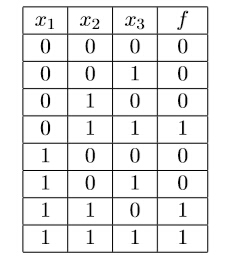
| Online Judge | Online Exercise | Online Teaching | Online Contests | Exercise Author |
|
F.A.Q Hand In Hand Online Acmers |
Best Coder beta VIP | STD Contests DIY | Web-DIY beta |
NAND
Time Limit: 2000/1000 MS (Java/Others) Memory Limit: 262144/262144 K (Java/Others)Total Submission(s): 685 Accepted Submission(s): 246
Problem Description
Xiaoqiang entered the ¡°shortest code¡± challenge organized by some self-claimed astrologists. He was given a boolean function taking n inputs (in C++):
bool f(bool x1, bool x2, bool x3){
//your code goes here
//return something
}
All possible inputs and expected outputs of this function have been revealed:

Xiaoqiang¡¯s code must be like:
bool a = NAND(b, c);
where ¡°a¡± is a newly defined variable,¡°b¡± and ¡°c¡± can be a constant (0/1) or a function parameter (x1/x2/x3) or a previously defined variable. NAND is the ¡°not-and¡± function:
NAND(b, c)=!(b&&c)
Because NAND is universal, Xiaoqiang knew that he could implement any boolean function he liked. Also, at the end of the code there should be a return statement:
return y;
where y can be a constant or a function parameter or a previously defined variable. After staring at the function for a while, Xiaoqiang came up with the answer:
bool a = NAND(x1, x2);
bool b = NAND(x2, x3);
bool y = NAND(a, b); return y;
Xiaoqiang wants to make sure that his solution is the shortest possible. Can you help him?
bool f(bool x1, bool x2, bool x3){
//your code goes here
//return something
}
All possible inputs and expected outputs of this function have been revealed:

Xiaoqiang¡¯s code must be like:
bool a = NAND(b, c);
where ¡°a¡± is a newly defined variable,¡°b¡± and ¡°c¡± can be a constant (0/1) or a function parameter (x1/x2/x3) or a previously defined variable. NAND is the ¡°not-and¡± function:
NAND(b, c)=!(b&&c)
Because NAND is universal, Xiaoqiang knew that he could implement any boolean function he liked. Also, at the end of the code there should be a return statement:
return y;
where y can be a constant or a function parameter or a previously defined variable. After staring at the function for a while, Xiaoqiang came up with the answer:
bool a = NAND(x1, x2);
bool b = NAND(x2, x3);
bool y = NAND(a, b); return y;
Xiaoqiang wants to make sure that his solution is the shortest possible. Can you help him?
Input
The first line contains an integer T (T ¡Ü 20) denoting the number of the test cases.
For each test case, there is one line containing 8 characters encoding the truth table of the function.
For each test case, there is one line containing 8 characters encoding the truth table of the function.
Output
For each test case, output a single line containing the minimum number of lines Xiaoqiang has to write.
Sample Input
1 00010011
Sample Output
4
Hint
Due to the small input domain, you can solve all the cases on your computer and submit a program with a table of all the answers.
Source
| Home | Top |
Hangzhou Dianzi University Online Judge 3.0 Copyright © 2005-2024 HDU ACM Team. All Rights Reserved. Designer & Developer : Wang Rongtao LinLe GaoJie GanLu Total 0.000000(s) query 1, Server time : 2024-11-22 04:31:48, Gzip enabled |
Administration |